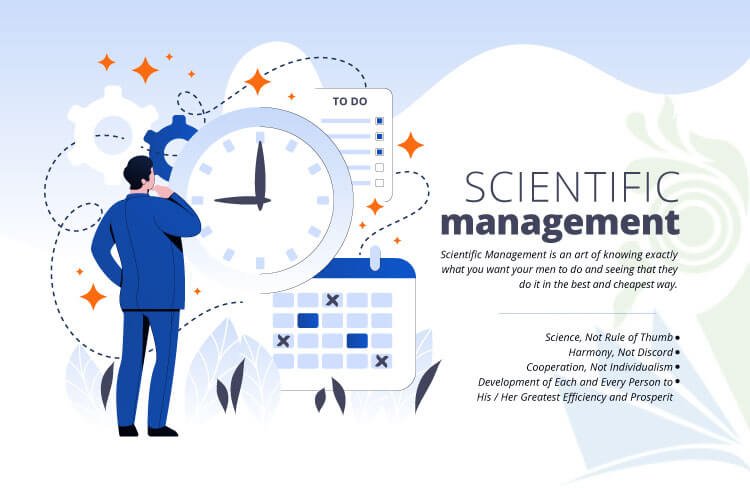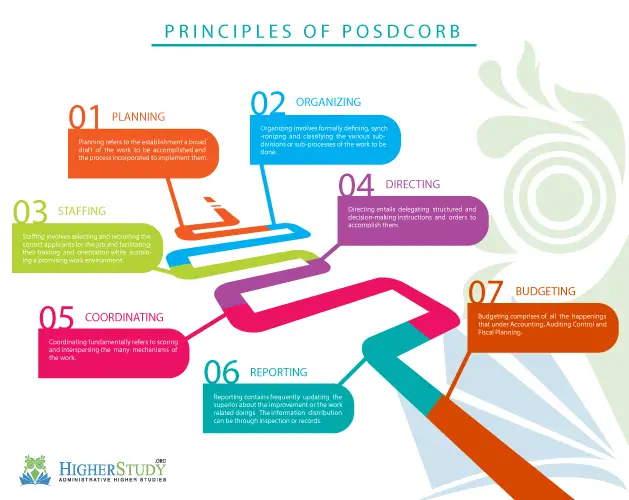Scientific Management Theory by Taylor, 4 Principles
The Principles of Scientific Management by F.W. Taylor
This article will describe Frederick Taylor’s Scientific Management Theory. At first, we know about Taylor and his contributions. Frederick Winslow Taylor was born on March 20, 1856, in Germantown, Philadelphia, Pennsylvania, USA. He was a mechanical engineer. He is the Father of the Scientific Management Approach. And also, popularized as the Father of the Industrial Engineering and Efficiency Movement. Besides, he contributed to different works, such as Managers and Workers, rhetorical techniques, scholarly debate about increased efficiency moving pig iron at Bethlehem’s Iron and Steel, management theory, and relations with ASME (American Society of Mechanical Engineers). He published several books, for instance,
- Shop Management (1903),
- The Principles of Scientific Management (1911),
- A Treatise on Concrete, Plain, and Reinforced: Materials, Construction, and Design of Concrete and Reinforced Concrete (1911)
- Concrete costs (1912)
And wrote some of the articles, such as
- Notes on Belting (1894) in Transactions of the American Society of Mechanical Engineers, Vol. XV
- A Piece-rate System (1895) in The Adjustment of Wages to Efficiency
- Shop Management (1903) in Transactions of the American Society of Mechanical Engineers 24
- On the Art of Cutting Metals (1906) in Transactions of the American Society of Mechanical Engineers, Vol. XXVIII
Finally, he died on March 21, 1915 (aged 59) in Philadelphia, Pennsylvania, USA.

What is Scientific Management Definition?
Frederick Taylor’s theory is a theory of management. It synthesizes and analyzes workflows. Its major purpose is improving, especially labor productivity, and economic efficiency. It was an old effort to apply science to the engineering of procedure and management. However, there is given a definition. For example:
Scientific Management approach is an art of knowing exactly what you want your men to do and seeing that they do it in the best and cheapest way.
— Frederick W. Taylor
Firstly, its name was adopted as “shop management” and “process management,” then took this name. Its other name is Taylorism or Scientific Process. Although Taylor is a pioneer of this theory, another seven leaders extended Taylor’s effort. They were Henry Laurence Gantt, Carl Georg Lange Barth, Horace King Hathaway, Morris Llewellyn Cooke, Sanford Eleazer Thompson, Frank Bunker Gilbreth, and Harrington Emerson.
Read: 14 Points of Deming in TQM
Objectives of Frederick Taylor’s Theory :
The major objective of Frederick Taylor’s contribution to management; are the maximum improvement of workers. This improvement shows efficiency and effectiveness performance. Such development is the revolution in management procedure and employees’ actual performance.
If the procedures and scientific theory of management examples apply, it can hugely change the following things. For instance:-
- Prevent the wastage of time.
- Reduce the cost of production.
- Secure the labor in the industry.
- Increase the efficiency of the workers.
- Develop the relationship between workers and managers.
Frederick Taylor’s Scientific Management Principles:
Frederick Winslow Taylor mentioned the core principles of management in his Principles of Scientific Management book. These principles refer to Frederick Taylor’s theory. Such as:-
- Science, not the Rule of Thumb
- Harmony, not Discord
- Co-operation, not Individualism
- Maximum, not Restricted Output
1. Science, not the Rule of Thumb:
The basic principles of scientific management theory by Taylor, are adopting a scientific approach to decision-making. Even abandons the unscientific approach from managerial activities. So, we can say that these principles suggest thinking before doing. Read more about the Science, Not Rule of Thumb.
2. Harmony, not Discord:
An organization consists of two groups, i.e., ‘workers’ and ‘management.’ They must create the ‘Give and Take’ relationship in the workplace. Therefore, Taylor emphasized the Mental Revolution, which means a change of attitude of both groups based on this principle. They should share their opinions and ideas with each other.
3. Co-operation, not Individualism:
It shows the importance of each other (management and workers). Management should reward and appreciate the employees for their helpful suggestions. At the same time, employees also cooperate with the management for the improvement of the organization.
4. Maximum, not Restricted Output:
Maximum productivity is the basic purpose of an organization. In this case, Taylor has emphasized production maximization in his principles.
Functions of Scientific Management Approach:
From Taylorism, we can find some significant functions. These functions positively help the administrators in their organization’s leadership. Such as:-
- According to the skills and abilities, an employee must be selected.
- Incentives and wages have to be installed to enhance their output and encouraging them.
- Implemented those methods which are based on scientific tasks.
- Carefully observe eradicating interruptions when the plan runs.
- In an organization, leadership should develop and standard.
Features of Frederick Taylor’s Theory:
According to Taylor, we can find some important features in Scientific Management Theory. Here has described those important features. Such as:
- Universal: Its principles apply to all kinds of organizations, businesses, non-business, and all levels of management. Therefore, they are all-pervasive or universal.
- Flexible: Here available some flexible features. For example, dynamic guidelines, non-static rules, and sufficient room for managerial discretion, Modification, and improvement.
- Cause & Effect Relationship: It indicates what will be the result of particular actions. So, if one is known, the other can be detected.
- Aims at Influencing Human Behavior: Human behavior is not simple and predictable. It always tries to deal with human behavior so that employees can be able to give the best result.
- Equal Importance: To achieve the organization’s goal, we have to prioritize all things. These principles are the best examples of equal importance.
- Scientific Selection, Training, and Development of Workers: In the organization, workers must select, train, and develop in a scientific way.
- Equal Division of Responsibility between Management and Workers: Each business environment has to ensure an equal division of responsibility between management and workers.
Techniques of Frederick Taylor’s Theory:
Ensuring any method or process, needs proper technique. Principles of scientific management theory by Traylor has effective techniques to implement. These are included in those techniques. Such as:-
- Work-Study (time study, method study, motion study, and fatigue study)
- Development of Functional Foremanship
- Standardization of Tools and Equipment
- Scientific Selection, Placement, and Training
- Introducing Costing System
- Mental Revolution
Criticism of Scientific Management Theory by Taylor:
Although it appreciates the organizational process, it has not spared severe criticism. The criticism of Frederick Taylor’s theory is divided into two categories. Such as:-
Workers Viewpoint
- For increasing productivity, replace the machine instead of the man. Therefore, it may be an unemployment tool.
- Exploitation thinking arises in workers. So, they are not engaged in creative work.
- These principles enforce over-speeding at work. So, These harm the health of employees.
- Due to extreme specialization, the employees are not capable of taking a drive on their own. Their position decreases mere cogs in the wheel. As a result, the job becomes dull. Employees are disappointed in working.
- Workers feel that these principles make the Trade Union. So, workers don’t attract these principles.
Employer’s Viewpoint
- It is an expensive system.
- Here enforces the work, study, standardization, and specialization. As a result, it is a time-consuming process.
- This procedure is one kind of deterioration of quality.
Importance of Scientific Management Theory in Office:
Taylorism by Taylor is perfectly suitable in an office. It can dramatically change the office environment in a positive mode. So, every office should adopt this theory for its actual success. However, there are some important reasons why taking this theory into office. For example:-
- Planning or Deciding the work in advance.
- Posting the right man for the right job.
- Initiating of incentive or reward wage plan.
- Confirmation of ideal of performance.
- Advise the right development of work.
- The removal of de trop flow of work.
- The upgrade of the worker-management affair.
Read more: 10 Best Books for a Businessman
Summary:
If you observe Frederick Taylor’s scientific management theory, you can find two major things. Such as:
- Firstly, a philosophy about how members of staff behave.
- Secondly, a set of ethics to maximize efficiency and effectiveness based on this philosophy.
Major Contributors to Scientific Management Theory
As discussed, Frederic Taylor is called the father of Scientific Management Theory. However, many more scholars have contributed to the establishment of this Scientific Management Theory. Some of them are mentioned below in honor.
-
- Henry Laurence Gantt (1861-1919): The Gantt Chart, Industrial Efficiency, The Task and Bonus System, and The Social Responsibility of Business are his main contributions of.
- Carl Georg Lange Barth (1860-1939): Frederick W. Taylor hired Barth to work with him at Bethlehem Steel Company. Frederick W. Taylor was hired to work with him at Bethlehem Steel Company. He helped to develop the speed and feed calculating slide rules.
- Horace King Hathaway (1878-1944): He is considered the foreman of scientific management.
- Morris Llewellyn Cooke (1872-1960): He worked directly with Taylor in scientific management. He is said to have been one of the four associates Taylor selected for his work. Moreover, he gave a clear idea about rural electrification.
- Sanford Eleazer Thompson (1867-1949): Thompson was a key collaborator of Frederick Winslow Taylor and played an important role in the development of time studies, especially in the building industry.
- Frank Bunker Gilbreth (1868-1924): He was an early supporter of scientific management and a pioneer of the time and motion study. He is perhaps best known as the central figure and father of Cheaper by the Dozen.
- Lillian Evelyn Moller Gilbreth (1878-1972): She and her spouse (Frank Bunker Gilbreth) were well-known contributors to building up the field of motion study, human factors, and industrial engineering.
- Harrington Emerson (1853-1931): He worked together with Taylor in Shop Management. Besides, his contribution held on The idea of setting up standards, Earlier efforts in the field of systematizing management, and Betterment work.
| Contributors | Contributions |
|---|---|
| Henry Gantt | The Gantt Chart, Industrial Efficiency, The Task and Bonus System, and The Social Responsibility of Business |
| Carl Georg Barth | Helping to develop the speed and feed calculating slide rules at Bethlehem Steel Company with Taylor. |
| Horace K. Hathaway | The foreman of scientific management |
| Morris L. Cooke | He gave a clear idea to Taylor about rural electrification. |
| Sanford E. Thompson | He played an important role in the building industry and the development of time studies with Taylor |
| Frank Bunker Gilbreth | A pioneer of the time and motion study as well as a father of Cheaper by the Dozen |
| Lillian Moller Gilbreth | Directly contributed to building up the field of motion study, human factors, and industrial engineering |
| Harrington Emerson | Earlier efforts in the field of systematizing management, and Betterment work |
Read More: A Brief History of Human Resource Management (HRM)




What’s up to all, how is the whole thing, I think every one is getting more from this web site, and your views are pleasant for new visitors.
Generally, I don’t read article on blogs, however, I wish to say that this write-up very forced me to take a look at and do so! Your writing style has been amazed me. Thanks, very nice article.
I’m very happy to discover this great site. I need to to thank you for ones time due to this fantastic read!! I definitely liked every bit of it and i also have you saved as a favorite to check out new stuff in your blog.
Great post. I used to be checking constantly this blog and I’m impressed!
Very helpful info particularly the last phase :) I handle such information a lot. I used to be seeking this particular information for a very lengthy time. Thanks and best of luck. a dream of trains content hosting
There’s certainly a lot to find out about this topic. I love all of the points you’ve made.
Outstanding post however I was wondering if you could write a little more on this topic? I’d be very thankful if you could elaborate a little bit more. Thank you!
Thanks for your comment and a request. We update our content regularly. We will take your request seriously. And we will try to extend this discussion in a little more (very soon).